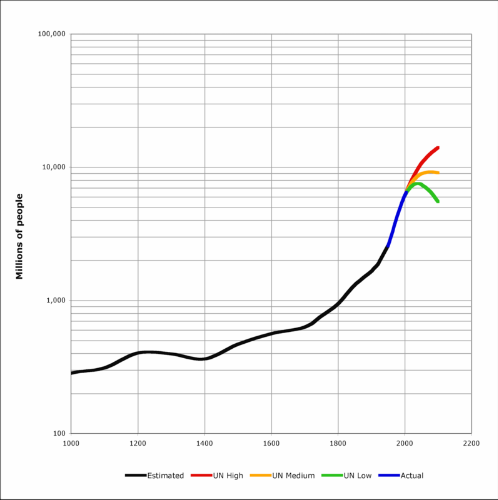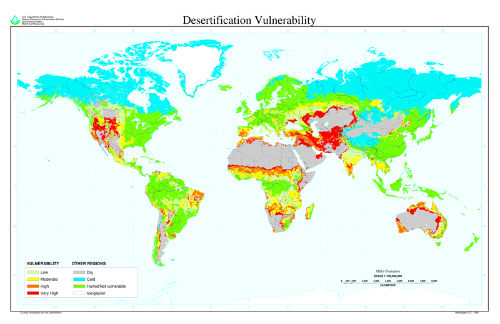Thomas Malthus, an English economist of the late 18th and early 19th centuries, is famous for prophesying doom in the form of excessive population growth and the resultant crash that would follow; though he’s been dead for the better part of two centuries, his ideas still inform a number of prominent figures to this day. Originally, his premise was that population growth would place stresses on a finite food supply, causing multitudes to starve. While his particulars may be off, resource shortages, real and imagined, are definitely a concern at the moment, freshwater and fossil fuels being two of the most prominent. Where, exactly, do we stand in relation to catastrophic resource shortages, and what can be done about it?

The first picture shows world population on a logarithmic scale- the current population is estimated at about 6.6 billion.
As for population growth, demographers often speak in terms of the doubling time of a population. This value can be determined by dividing 70 by the growth rate in percent. According to the CIA World Factbook, the present world population growth rate is 1.188%, which gives us a doubling time of about 58.9 years. The rate does appear to be decreasing, so we can at least rest easy on that account. Still, on the basis of this chart, it would seem obvious that we’re likely to exceed ten billion by the end of the century, all else being equal.
However, the rate at which developing countries are increasing their resource use is a definite concern. Let’s work with three examples- soil, water, and energy.
In the case of energy, the estimated per capita energy consumption in 2003 was equivalent to 1.6 metric tons of oil per person, or ten billion tons in total- converted into barrels, this works out to around 200 million barrels per day. (Thankfully, all of this is not in the form of oil!) If we projected our future rate of consumption based on the 2003 estimate, a population of ten billion would mean an increase to 328 million barrels/day, however, with the growing standard of living (and commensurate increase in energy usage) in developing nations, that number is surely going to rise. The global demand for energy is already at a high, and, while record energy prices have made the extraction of hard-to-reach fossil fuels profitable, nonrenewable fuels cannot sustain such an energy appetite indefinitely. [ad name="Adsense Small Horz Banner"] Worse is the situation concerning water- while most of the planet may be covered with water, the amount of freshwater available is a fraction of that total.
Global water footprint per capita was ~1200 cubic meters/year in the period 1997-2003 (ranging from a low of 702 for China to a high of 2,483 for the US on a list of selected countries), with the lion's share being used for industrial and agricultural uses. The majority of accessible fresh water is groundwater, a source that is being depleted at an increasingly rapid rate and requires long periods of time to recharge. This situation is being complicated by the destruction of wetlands that serve as nature’s water filtration systems and the use of large areas of impervious surface in urban centers (such areas increase runoff, which in turn increases the rate at which freshwater enters the ocean and becomes inaccessible). Deforestation also contributes to the problem, since plants serve to trap water and return it to the atmosphere via transpiration. Not least of the human-induced factors is industrial and agricultural pollution, both of which can render water undrinkable with minimal (on a quantitative basis) amounts of chemical inputs.
Soil may seem an odd thing to put on a list of resources being depleted, but that is precisely what is occurring in some regions of the world. Soil is a complex ecosystem in and of itself, consisting of minerals, organic matter, and macro- and microorganisms, All soil is not equal, and the mineral (and organic) content, pH, water capacity, and drainage of a soil all combine to give soils a distinct character that is best suited to supporting certain kinds of vegetation. Agricultural practices such as tilling and irrigation improve the short-term yield of a soil at the expense of its long-term viability, forcing the use of more chemical fertilizers that, in turn, harm the environment via algal blooms and the resultant dead zones. Runoff erodes topsoil at a rate that can turn farming into a form of mining the land (some estimates place the loss of agricultural land as high as 24 million acres per year).
Food pressures are adding even more pressure to the mix, as indicated by the last two years’ widespread rice shortages and increases in the price of wheat and corn. Add to this the 40 kg of meat that each of us consumes per day on average, and the result is quite a situation to deal with…


